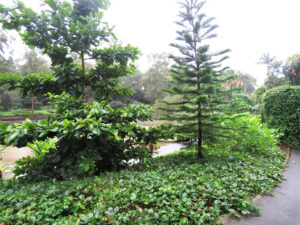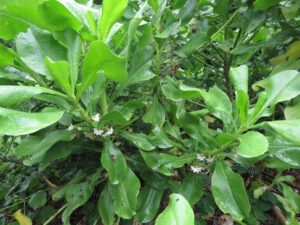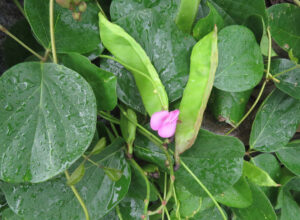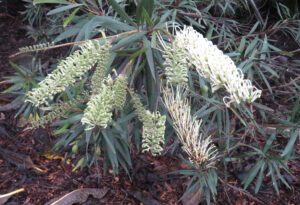
Brisbane Botanic Gardens Mt Coot-tha
By Dale Arvidsson
Brisbane’s enviable subtropical climate allows gardeners and landscapers the opportunity to successfully grow an extremely wide variety of flora that originates from tropical, subtropical, and even temperate climates around the globe.
Brisbane Botanic Gardens Mt Coot-tha is Queensland’s premier subtropical botanic gardens and features a variety of spectacular living collections. Many of these collections follow educational themes and the collections at the Mt Coot-tha Gardens’ site feature categories ranging from geographic to climatic and conservation to amenity horticulture, that are both educational and inspirational for the Garden’s 1.5 million visitors annually.
A ‘new’ collection
One of the more recent geographic collections developed is the Pacific Flora Garden. This garden came from the dual need to relocate an existing collection, whilst providing an improved visitor experience. The result is a tropical-themed display garden that will mature to feature swaying Coconut palms (Cocos nucifera) and tall, stately, Cook Pines (Araucaria columnaris), right next to one of the site’s scenic waterlily-filled lagoons.
Whilst this new garden was established in 2020, it is not the first time that a formal collection displaying the flora of the Pacific has been grown at Brisbane Botanic Gardens. The original collection was established in the mid 1980’s and featured flora from the wider ‘Pacific’ including New Zealand, Lord Howe, Norfolk and Phillip Islands. The combination of the relocation of the Queensland Herbarium to the botanic gardens in 1998 onto part of the original collection site of the Pacific collection, along with the millennium drought (1995-2009) saw the remains of the collection struggling to perform in dry, skeletal soils on a hot north-west facing slope. By 2015, the collection did not present well nor was it much visited or used by the public.
The redevelopment of this collection in a more suitable location was highlighted in the Brisbane Botanic Gardens Mt Coot-tha Master Plan 2018 which identified a new site for a revitalised display. Positioned adjacent to one of the Gardens’ popular scenic lagoons, this area featured deeper and moister soils, and higher humidity to successfully display the flora of one of eastern Australia’s nearest geographic neighbours.
The flora of the collection is based on the World Geographical Scheme for Recording Plant Distributions and includes flora native to Fiji, New Caledonia, Samoa, Tonga, Vanuatu, and Hawaii, however these plants may also have a natural wider distribution outside of the Pacific, including being native to Australia.
Some highlighted plants from the collection
Here are just a few of the plants featured in the Pacific Flora Garden which have excellent horticultural potential and can be grown in a wide variety of settings.

Octopus Bush Argusia argentea
This is a dome-shaped, architectural shrub in the Boraginaceae family that can grow to 5m tall. Octopus Bush features attractive silvery-green leaves with a velvety appearance. The small white spikes of flower clusters appear all year and as they age, resemble the legs of a small green octopus, hence the common name for this species.
As well as being common to many Pacific islands, this salt-tolerant species is also native to Australia where it grows in sandy or rocky, well drained soils along the coast, from Fraser Island north to the Torres Strait, on many of the Great Barrier Reef islands, and in the Northern Territory. In the Pacific, this species is typically seen on many coastal cays and atolls, often growing just about the high-tide mark. Octopus Bush is used in many Pacific islands as a traditional medicine.

Sea Lettuce Scaevola taccada
Sea Lettuce is a succulent spreading shrub in the Goodeniaceae family, growing from 2-4m tall. At first glance, you may not see the connection with other well-known groundcover scaevolas (Fan Flowers) and this large-leaved, tropical looking plant, until you notice the small, white fan-shaped flowers typical of the genus.
In the Pacific, Sea Lettuce occurs naturally on many islands, colonising young coral sand cays. This plant can often be seen growing in the wild with Octopus Bush.
Sea Lettuce was used as a traditional medicine. It can be grown to make an excellent coastal windbreak and is very salt tolerant. In Australia, this species occurs in Queensland, the Northern Territory and Western Australia.

Beach BeanCanavalia rosea
This vigorous vine in the Fabaceae family has small, attractive pink flowers and thick green seed pods.
Beach Bean is used in the Pacific Flora Garden as a groundcover where it has spread rapidly, helping to reduce weeds and retain soil moisture by thickly shading the soil. It provides a lush tropical display and does require plenty of room to spread.
The species typically inhabits the upper beach, dunes, and coastal cliffs throughout the tropics, where it can usually be found sprawling over the ground or twining up nearby vegetation. Found on most Pacific islands, Beach Bean is also native to Queensland, the Northern Territory, Western Australia and New South Wales. It prefers sandy soils and is highly salt tolerant.

Grevillea exul
Many horticulturists are unaware that the genus grevillea in the Proteaceae family is not native only to Australia. Three species of grevillea can also be found in New Guinea, one species is native to Indonesia, and several species are endemic to New Caledonia.
Grevillea exul can grow to 10m tall in its native New Caledonia where it naturally grows in elevated and exposed locations. Plants growing at the Brisbane Botanic Gardens have grown to just over 2m x 2m after 10 years. The attractive flowers are white to cream with green stigmas, and are held above narrow dark green leaves. It has proven itself to be a hardy addition to the Gardens’ living collections, requiring little care once established.
Cover image: The Pacific Flora Garden
For more information on Brisbane’s Botanic Gardens visit www.brisbane.qld.gov.au
References
World Geographical Scheme for recording plant distributions: https://en.wikipedia.org/wiki/List_of_codes_used_in_the_World_Geographical_Scheme_for_Recording_Plant_Distributions
Plants of the World Online https://powo.science.kew.org/
Atlas of Living Australia www.ala.org.au
Queensland Herbarium www. https://www.qld.gov.au/environment/plants-animals/plants/herbarium
Wikipedia – https://www.wikipedia.org/
Dale Arvidsson
Curator Brisbane Botanic Gardens
